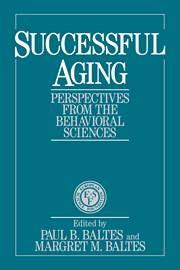Book contents
- Frontmatter
- Contents
- List of contributors
- Foreword
- Preface
- 1 Psychological perspectives on successful aging: The model of selective optimization with compensation
- 2 Medical perspectives upon successful aging
- 3 Successful aging in a post-retired society
- 4 The optimization of cognitive functioning in old age: Predictions based on cohort-sequential and longitudinal data
- 5 The optimization of episodic remembering in old age
- 6 Peak performance and age: An examination of peak performance in sports
- 7 Personal control over development and quality of life perspectives in adulthood
- 8 Successful mastery of bereavement and widowhood: A life-course perspective
- 9 The Bonn Longitudinal Study of Aging: Coping, life adjustment, and life satisfaction
- 10 Risk and protective factors in the transition to young adulthood
- 11 Avoiding negative life outcomes: Evidence from a forty-five year study
- 12 Developmental behavioral genetics and successful aging
- Name index
- Subject index
2 - Medical perspectives upon successful aging
Published online by Cambridge University Press: 22 March 2010
- Frontmatter
- Contents
- List of contributors
- Foreword
- Preface
- 1 Psychological perspectives on successful aging: The model of selective optimization with compensation
- 2 Medical perspectives upon successful aging
- 3 Successful aging in a post-retired society
- 4 The optimization of cognitive functioning in old age: Predictions based on cohort-sequential and longitudinal data
- 5 The optimization of episodic remembering in old age
- 6 Peak performance and age: An examination of peak performance in sports
- 7 Personal control over development and quality of life perspectives in adulthood
- 8 Successful mastery of bereavement and widowhood: A life-course perspective
- 9 The Bonn Longitudinal Study of Aging: Coping, life adjustment, and life satisfaction
- 10 Risk and protective factors in the transition to young adulthood
- 11 Avoiding negative life outcomes: Evidence from a forty-five year study
- 12 Developmental behavioral genetics and successful aging
- Name index
- Subject index
Summary
Introduction: The minimum morbidity model and the compression of morbidity
Successful aging, viewed from a medical or public health viewpoint, consists of optimizing life expectancy while at the same time minimizing physical, psychological, and social morbidity, overwhelmingly concentrated in the final years of life. Thus, the achievement of successful aging requires that the onset of infirmity, on average, increase more rapidly than average life expectancy, compressing morbidity into a shorter period (e.g., Fries, 1980, 1983, 1987a, 1987b; Fries & Crapo, 1981). Successful aging implies and requires morbidity compression.
The national illness burden in developed nations has shifted over recent decades from acute to chronic illness and from younger to older individuals (e.g., Fries & Crapo, 1981). Increasingly, the problems of chronic illness mix with and finally give way to problems of senescence. Our future population will contain more old individuals as successive birth cohorts continually increase in size and because, until recently, life expectancy from age 65 has also been increasing. Projections made from these trends have led some to postulate a gloomy future of increasing dependency, worsening health, and spiraling health care costs. The ability of society to pay ever-increasing costs for ever-more vegetative existence has been called into question.
However, there is the much more hopeful paradigm of the compression of morbidity elaborated here and elsewhere (e.g., Fries, 1988). Rather than assuming that disease is a fixed part of life and the life span indefinitely extensible, the compression of morbidity thesis states that the species' life span is finite and the onset of chronic disease is relatively easily delayed.
- Type
- Chapter
- Information
- Successful AgingPerspectives from the Behavioral Sciences, pp. 35 - 49Publisher: Cambridge University PressPrint publication year: 1990
- 26
- Cited by



